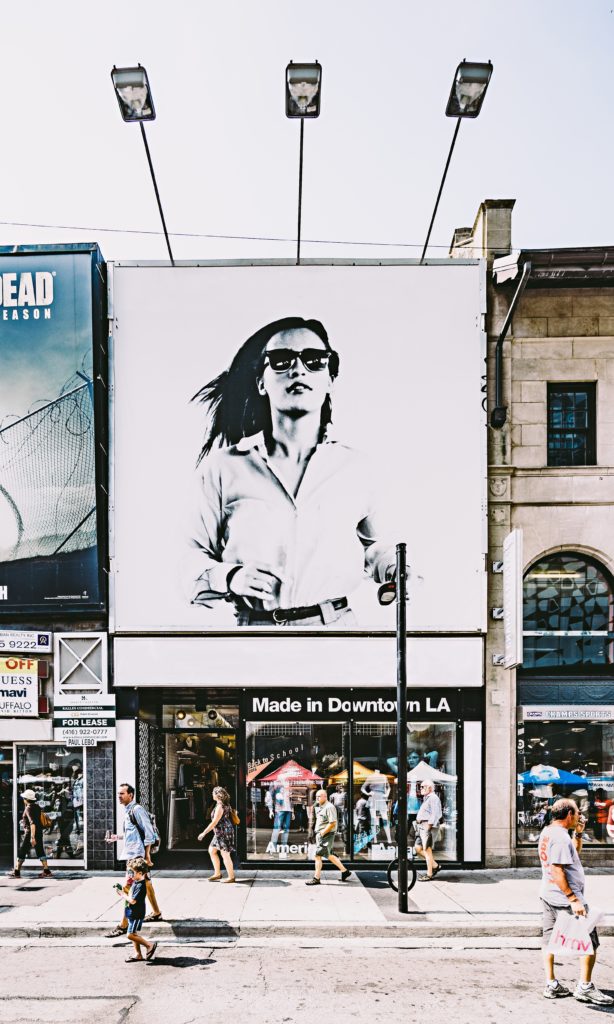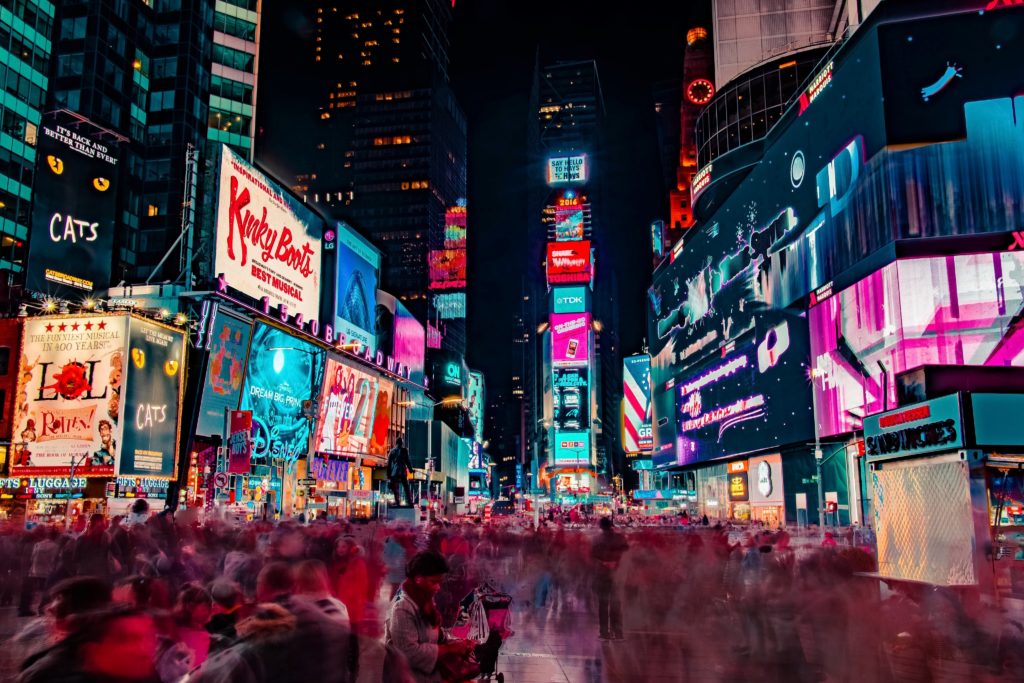Outdoor advertising :: a short guide
Outdoor advertising is a great way to reach a large audience with your marketing message. But before you start designing your next billboard or bus stop ad, there are a few things you need to know.
In this blog, we will make a short introduction to what outdoor advertising is, what are its types and the advantages and disadvantages of such marketing.
What is outdoor advertising?
Outdoor advertising can be defined as a form of marketing that involves the use of physical outdoor spaces to promote products and services. This can include anything from billboards and bus stop advertisements to street furniture (advertisements on benches, litter bins and light fixtures), buildings and different means of transport.
Outdoor advertising is a popular marketing strategy because it allows businesses to reach a large audience with minimal effort. However, it can be expensive and it’s important to carefully consider your goals before investing in a campaign.
Planning an outdoor ad campaign
When planning an outdoor advertising campaign, you need to keep several things in mind:
- Consider the overall goals of the campaign. What do you hope to achieve?
- Think about your target audience. Who do you want to reach with your message?
- Choose the right place. Outdoor advertising depends on the location, so be sure to choose a place that will have a lot of traffic.
- Think about the budget. Outdoor advertising can be expensive, so be sure to set a budget and stick to it.
Advantages of outdoor advertising
One of the most important advantages of outdoor advertising is its ability to reach a wide range of people. Billboards, bus stop ads, and other forms of outdoor advertising are often placed in busy locations, meaning they have the potential to reach large numbers of people. Outdoor advertising is also a relatively cheaper way to reach potential customers. Compared to other traditional forms of advertising, such as television or radio, outdoor advertising is relatively affordable. However, it still belongs to the more expensive forms of advertising, especially compared to advertising on social networks.
Another advantage of outdoor advertising is that it is difficult to ignore. Unlike other forms of advertising, which can be easily ignored or forgotten, outdoor advertising is hard to miss. This means that they are more likely to attract the attention of potential customers, even if they are not actively looking for a product or service.

How to design outdoor ads
When it comes to outdoor ad, there’s a lot that goes into the design process. From the planning stage to execution, every detail needs to be taken care of in order to create a successful advertisement.
When choosing an outdoor ad location, businesses must consider their target audience. Businesses should place their ads in locations where they are likely to reach their target audience. Additionally, businesses should consider placing other ads in the area to ensure their ad stands out.
CONCEPT
One of the most important aspects of designing a billboard is the concept. The concept is what will ultimately sell the product or service, so it’s important to come up with something that is innovative and attention-grabbing. The concept should be able to convey the message of the ad in an understandable way. This part of the job is done by a marketing agency or graphic design studio if they are experienced in designing billboards and other forms of outdoor advertising. Also, many professional photographers create concepts in cooperation with agencies.
DESIGN
Once the concept is determined, the next step is to create the actual billboard design. This is where the creativity of the designer comes to the fore. The design should be attractive and should complement the concept. This means they need to consider colors, fonts and the overall look of the ad.
The colors of the outdoor advertisement should be striking and attract attention. The ad should use simple fonts that are easy to read, and the overall appearance of the ad should be clean and concise.
A graphic designer is responsible for the design.
LOCATION
As with real estate, the golden rule applies to outdoor advertising: location, location, location. The location of the billboard will play a large role in determining its success. It needs to be placed in a place where it will be seen by a large number of people, but also the people you want to attract.
Printing and Installation
Once the design is complete, the last step is printing and installing the ad. This is usually done by a professional printing company. Once the ad is up, it’s important to monitor it to make sure it’s still in good shape.
Types of outdoor advertising
Outdoor advertising takes many forms, from billboards and citylights to flyers and posters. Each type of outdoor advertising has its advantages and disadvantages.
Billboards and citylights
They are one of the most common types of outdoor advertising. They are usually large and prominent, making them hard to ignore. However, billboards are expensive and can only be used to promote one product or service.
Public transport and surfaces
This is another popular type of advertising. Advertising on public transport is usually cheaper than advertising on billboards, and it can reach a large number of people. However, public transport advertising is often less effective than other forms of outdoor advertising. Many cities also prohibit advertising on public transport, so this should also be taken into account.
This is why advertising on public surfaces such as bus shelters, benches and public lighting poles is a better option. This form of advertising is cheaper than billboards and also effective. Although it will reach a smaller number of people (mostly only pedestrians will see this form of advertising), it is still an extremely large number of users.

FLYERS AND POSTERS
Flyers and posters are another type of outdoor advertising. Flyers and posters are usually less expensive than other forms of outdoor advertising and can be placed in a variety of locations. However, they are often easy to ignore and may not reach the intended audience.
Digital outdoor advertising
Digital outdoor advertising is a type that uses digital displays instead of traditional billboards or posters.
It is often more expensive than traditional forms, but it also offers a number of advantages:
Flexibility
It is more flexible than traditional forms of outdoor advertising. It can be used to target specific demographics and can be changed regularly. This means that businesses can use digital outdoor advertising to test different marketing messages and strategies.
LOOK
Digital outdoor advertising is also more attractive than traditional forms of outdoor advertising. It can be used to display interactive content, such as movies, animations, games, etc., which can attract the attention of potential customers.
Despite its advantages, digital outdoor advertising is not without its drawbacks. One of the biggest challenges of digital outdoor advertising is the short attention span of potential customers. With so many distractions, it can be difficult to capture the attention of potential customers and hold their interest long enough to promote a product or service.
When choosing a type of outdoor advertising, businesses should consider the cost-benefit options that fit their goals and budget. Outdoor advertising is a powerful marketing tool, but it is important to use it effectively.
The effect of outdoor advertising on society
We cannot write about outdoor advertising without mentioning its positive and negative impact on society.
Positive aspects of outdoor advertising
Outdoor advertising has a positive impact on the company, that is, the product or service that the company promotes, as we mentioned earlier. However, apart from that commercial part, outdoor advertising can also be used to raise awareness, not only of brands, but also campaigns of non-profit associations and government organizations for the purpose of promoting a healthier life, awareness of important topics such as the fight against violence or the fight against addiction, etc. Since this type of advertising reaches a large number of people, it is good for informing the public about important topics and helping to create a different perception towards some of them.
Negative aspects of outdoor advertising
There are also several disadvantages of outdoor advertising. First, it can be expensive. Second, it can be difficult to measure the success of a campaign. And thirdly, some people consider it a form of pollution.
Visual pollution
Outdoor advertising can cause visual pollution. This happens when an area is overcrowded with advertisements to the extent that it causes distraction and stress to passers-by and residents of an area. Visual pollution can reduce the quality of life in an area and make it less livable.
There are several ways to reduce the visual pollution caused by outdoor advertising. First, limit the number of ads in the area. Second, use a smaller ad format and simpler design. Third, use ads that blend in with the environment.

The impact of outdoor advertising on the environment
Outdoor advertising can have a negative effect on the environment. Billboards (billboards, city lights and others), for example, are often made of vinyl, which is a type of plastic. Plastic takes hundreds of years to break down, so when the ad is removed, the material often ends up in landfills unrecycled. Advertisements in public spaces, such as flyers and posters, can also create litter.
There are several ways to reduce the negative impact of outdoor advertising on the environment. Use recycled materials whenever possible. Then, use biodegradable materials. Avoid using single-use materials. And make sure materials are properly sorted for recycling.
Outdoor advertising can have a positive or negative effect on the environment, depending on how it is used.
CONCLUSION
When it comes to outdoor advertising, professional help is often needed to achieve the desired results. However, by understanding the key aspects of outdoor advertising, you can increase your chances of creating a successful advertisement.
Outdoor advertising is constantly evolving. New technologies provide companies with more opportunities to reach potential customers. For example, businesses can now use digital displays to target specific demographics.
As outdoor advertising evolves, businesses need to be aware of the latest trends. By following the latest trends, they can ensure the effective use of outdoor advertising.
For more articles on graphic design and marketing, visit our blog.
If you need any of the design services, feel free to contact us via email or contact form.
Thank you for reading!





